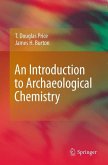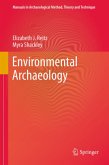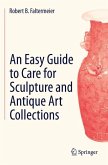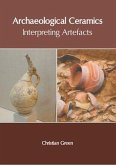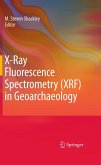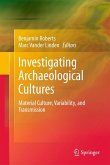- Gebundenes Buch
- Merkliste
- Auf die Merkliste
- Bewerten Bewerten
- Teilen
- Produkt teilen
- Produkterinnerung
- Produkterinnerung
Many archaeologists, as primarily social scientists, do not have a background in the natural sciences. This can pose a problem because they need to perform chemical and physical analysis on samples to perform their research. This manual will be an essential source of information for those students without a background in archaeological science, but be a comprehensive overview that those with some science background will still find useful. The manual will provide readers with the knowledge to use archaeological science methods to the best advantage. It will describe and explain the analytical…mehr
Andere Kunden interessierten sich auch für
![An Introduction to Archaeological Chemistry An Introduction to Archaeological Chemistry]() T. Douglas PriceAn Introduction to Archaeological Chemistry67,99 €
T. Douglas PriceAn Introduction to Archaeological Chemistry67,99 €![An Introduction to Archaeological Chemistry An Introduction to Archaeological Chemistry]() T. Douglas PriceAn Introduction to Archaeological Chemistry75,99 €
T. Douglas PriceAn Introduction to Archaeological Chemistry75,99 €![Environmental Archaeology Environmental Archaeology]() Elizabeth J. ReitzEnvironmental Archaeology75,99 €
Elizabeth J. ReitzEnvironmental Archaeology75,99 €![An Easy Guide to Care for Sculpture and Antique Art Collections An Easy Guide to Care for Sculpture and Antique Art Collections]() Robert B. FaltermeierAn Easy Guide to Care for Sculpture and Antique Art Collections38,99 €
Robert B. FaltermeierAn Easy Guide to Care for Sculpture and Antique Art Collections38,99 €![Archaeological Ceramics: Interpreting Artefacts Archaeological Ceramics: Interpreting Artefacts]() Archaeological Ceramics: Interpreting Artefacts155,99 €
Archaeological Ceramics: Interpreting Artefacts155,99 €![X-Ray Fluorescence Spectrometry (XRF) in Geoarchaeology X-Ray Fluorescence Spectrometry (XRF) in Geoarchaeology]() X-Ray Fluorescence Spectrometry (XRF) in Geoarchaeology38,99 €
X-Ray Fluorescence Spectrometry (XRF) in Geoarchaeology38,99 €![Investigating Archaeological Cultures Investigating Archaeological Cultures]() Investigating Archaeological Cultures112,99 €
Investigating Archaeological Cultures112,99 €-
-
-
Many archaeologists, as primarily social scientists, do not have a background in the natural sciences. This can pose a problem because they need to perform chemical and physical analysis on samples to perform their research. This manual will be an essential source of information for those students without a background in archaeological science, but be a comprehensive overview that those with some science background will still find useful.
The manual will provide readers with the knowledge to use archaeological science methods to the best advantage. It will describe and explain the analytical techniques in a manner that the average archaeologist can understand, and outline clearly the requirements, benefits, and limitations of each possible method of analysis, so that the researcher can make informed choices. The work includes specific information about the ways of analyzing most common types of archaeological samples, including:
-pottery and ceramics
-stone tools
-bone and teeth
-cultural rock
-organic residues
-shell and plant remains
-paints and pigments
- metal
-glass
-sediments
Since samples are often compromised or changed during experimentation, it is important to select the most effective technique for gaining the target information from the sample before proceeding. Readers will reach for this manual for whenever they need to decide how to best analyze a sample, and how to perform that analysis.
The manual will provide readers with the knowledge to use archaeological science methods to the best advantage. It will describe and explain the analytical techniques in a manner that the average archaeologist can understand, and outline clearly the requirements, benefits, and limitations of each possible method of analysis, so that the researcher can make informed choices. The work includes specific information about the ways of analyzing most common types of archaeological samples, including:
-pottery and ceramics
-stone tools
-bone and teeth
-cultural rock
-organic residues
-shell and plant remains
-paints and pigments
- metal
-glass
-sediments
Since samples are often compromised or changed during experimentation, it is important to select the most effective technique for gaining the target information from the sample before proceeding. Readers will reach for this manual for whenever they need to decide how to best analyze a sample, and how to perform that analysis.
Produktdetails
- Produktdetails
- Manuals in Archaeological Method, Theory and Technique
- Verlag: Springer / Springer New York / Springer, Berlin
- Artikelnr. des Verlages: 12182558, 978-1-4419-5703-0
- 2011 edition
- Seitenzahl: 603
- Erscheinungstermin: 1. Oktober 2010
- Englisch
- Abmessung: 242mm x 167mm x 43mm
- Gewicht: 1064g
- ISBN-13: 9781441957030
- ISBN-10: 1441957030
- Artikelnr.: 27807655
- Herstellerkennzeichnung
- Libri GmbH
- Europaallee 1
- 36244 Bad Hersfeld
- gpsr@libri.de
- Manuals in Archaeological Method, Theory and Technique
- Verlag: Springer / Springer New York / Springer, Berlin
- Artikelnr. des Verlages: 12182558, 978-1-4419-5703-0
- 2011 edition
- Seitenzahl: 603
- Erscheinungstermin: 1. Oktober 2010
- Englisch
- Abmessung: 242mm x 167mm x 43mm
- Gewicht: 1064g
- ISBN-13: 9781441957030
- ISBN-10: 1441957030
- Artikelnr.: 27807655
- Herstellerkennzeichnung
- Libri GmbH
- Europaallee 1
- 36244 Bad Hersfeld
- gpsr@libri.de
Dr. Mary Malainey is an associate professor of Archaeology at Brandon University, Manitoba, CA.
Part I Basic Science.
Chapter 1 Elements, Atoms and Molecules.
Matter and the Atom.
The Periodic Table of Elements.
Chemical Bonding.
Chemical Equations.
Cellular Energy.
Electrical Conductivity.
Chapter 2 Electromagnetic Radiation.
Wavelength, Frequency and Energy.
The Electromagnetic Spectrum.
Energy Absorption and Emission by Atoms and Molecules.
Chapter 3 Radioactive Isotopes and Their Decay.
Emissions.
Radioactive Decay.
The Uranium Decay Series.
Nuclear Reactions.
Chapter 4 Stable Isotopes.
Carbon.
Nitrogen.
Strontium.
Lead.
Oxygen.
Hydrogen.
Chapter 5 Organic Compounds.
Important Organic Compound Families.
Lipids.
Amino Acids and Proteins.
Carbohydrates.
Deoxyribonucleic Acid.
Chapter 6 Other Useful Concepts.
Acids and Bases.
Stereochemistry and the Polarimeter.
Chemical Reactions.
Part II Applications.
Chapter 7 Compositional Analysis.
Chapter 8 Radiocarbon dating.
Carbon
14.
Using Radioactive Carbon to Date Organic Material.
Counting ß Emissions.
Accelerator Mass Spectrometry Dating.
Conventional Radiocarbon Ages.
Carbon Exchange Reservoir.
Differences in Circulation Time in the Carbon Cycle.
Secular Variation.
Converting Radiocarbon Ages Into Calendar Dates.
Sampling Considerations.
Sample Pretreatment.
Current Issues in Radiocarbon Dating.
Less Destructive Sampling Techniques.
Judging the Quality of Radiocarbon Dates.
Conclusions.
Chapter 9 Other Radioactive Decay Based Dating Techniques.
Uranium Series Dating.
Using Uranium as a Clock.
Measuring Radioactivity.
Sample Selection.
Biogenetic materials and Uranium Uptake.
Sample Preparation.
Sample Contamination.
Potassium
Argon and Argon
Argon Dating.
The Production of Radiogenic Argon.
Procedures for Obtaining a K
Ar Date.
Procedures for Obtaining an Ar
Ar Date.
Fission Track Dating.
Sample Requirements.
Procedure.
Age Calculation.
Age Range and Potential Errors.
Chapter 10 Trapped Charge Dating.
Theoretical Considerations.
Measuring the Population of Trapped Charges.
Thermoluminescence Dating.
Optically Stimulated Luminescence Dating.
Electron Spin Resonance Dating.
Determining the Paleodose Dose.
Additive (Dose) Method.
Regeneration Technique.
Partial Bleach(ing) Technique.
Regeneration Method.
Single Aliquot Regeneration (SAR).
The Plateau Test.
Sources of the Annual Dose.
External Contribution.
Internal Contribution.
Uranium Uptake.
Dating Limitations and Sources of Error.
Potential Benefits of Trapped Charge Dating.
Chapter 11 Other Dating Techniques.
Amino Acid Racemization.
Archaeomagnetism.
Obsidian Hydration.
Cation Ratio.
Chapter 12 Provenance Studies.
Chapter 13 Stable Isotope Analysis.
Stable Carbon Isotope Ratio Analysis.
Sample Selection.
Factors Affecting d13C values.
Summary.
Stable Nitrogen Isotope ratio Analysis.
Sample Selection.
Factors affecting d15N Values.
Using Linear Mixing Models to Reconstruct Paleodiets.
Stable Strontium Isotope Analyses.
Strontium to Calcium Ratios.
Sample Selection and Processing.
Using Strontium Isotope Ratios to Trace Migrations.
Stable Lead Isotope Analysis.
The Occurrence of Lead in Metal.
The Study of Lead in Body Tissue.
Oxygen Isotope Analysis.
Oxygen Isotope Fractionation.
Sample Selection and Processing.
Chapter 14 Lipid Residues.
Chapter 15 Blood and Protein Analysis.
Protein and Blood.
Screening Techniques.
Microscopy.
Colorimetric Methods of Protein Determination.
Urinalysis Test Strips.
Techniques Used for Species Specific Identifications.
Hemoglobin (Hb) Crystallization.
Using the Immune Response to Identify Proteins.
Detecting the Antibody
Antigen Complex.
The Immune Response in Archaeological Residues.
Survival of Proteins.
Survival of Blood Proteins.
The Question of Reliability.
Cross Reactions and Antibody Selection.
Blind Test Results.
Blood Residues Vs. Faunal Assemblages.
Recent Studies.
Conclusions.
Chapter 16 Ancient DNA and the Polymerase Chain Reaction.
The Preservation of Ancient DNA.
The Polymerase Chain Reaction.
Analysis after Amplification.
Sample Selection.
Extraction.
Selection of DNA Primers.
Challenges Associated with Analyzing Ancient DNA.
Amplification of Poorly Preserved DNA.
Strategies for Managing PCR Inhibitors.
Avoiding Contamination.
Conclusions.
Special Topic: DNA Cloning.
Insertion of Foreign DNA into Cloning Vectors.
Plasmids.
Bacteriophages.
Special Topic: DNA Sequencing.
Part IIi Materials.
Chapter 17 Pottery and other Ceramic Artifacts.
Chapter 18 Flaked and Groundstone Tools.
Chapter 19 Bone and Teeth.
Chapter 20 Cultural Rock
Chapter 21 Food Residues.
Chapter 22 Blood Residues.
Chapter 23 Other Organic Residues.
Chapter 24 Organic Remains.
Chapter 25 Paint, Pigments and Ink.
Chapter 26 Metal.
Chapter 27 Glass.
Chapter 28 Matrix and Environmental Deposits.
Chapter 29 Other Materials.
Part Iv.
Instrumentation.
Chapter 30 Sample Selection and Processing.
Sample Solutions.
Analysis of Solid Samples.
Special Topic: LASER: Light Amplification by Stimulated Emission of Radiation.
Chapter 31 Mass Spectrometry.
Ionization.
Techniques for Molecular Mass Analysis.
Electron Impact.
Soft Ionization Techniques.
Techniques used with LC
MS.
Techniques of Atomic Mass Analysis.
Secondary Ion Mass Spectrometry.
Laser Ablation Mass Spectrometry.
Thermal Ionization Mass Spectrometry.
Mass Analysis.
Magnetic Sector.
Quadrupole.
Ion Trap.
Time of Flight.
Ion Detection.
Faraday Cup.
Photomultiplier.
Electron Multiplier.
Chapter 32 Instrumental Neutron Activation Analysis.
Radionuclide Formation and Emissions.
Sample Preparation and Analysis Identification and Quantification of Elements.
Chapter 33 Separation Techniques.
Chromatography.
Thin Layer Chromatography.
High Pressure (or Performance) LiquidChromatography.
Liquid Chromatography with Mass Spectrometry.
Gas Chromatography.
Component Separation.
Detectors.
Electrophoresis.
Electrophoresis of Proteins.
Isoelectric Focusing Point.
Separation by Weight.
Chapter 34 Atomic Absorption and Emission Spectroscopy.
Atomic Absorption Spectroscopy.
Sample Atomization.
Light Sources.
Detection.
Advantages and Disadvantages.
Optical Emission Spectroscopy.
Inductively Coupled Plasma
Atomic Emission Spectroscopy.
ICP with Mass Spectrometry.
Chapter 35 Optical Spectroscopy.
Ultraviolet and Visible Spectroscopy.
Instrumentation.
Infrared Spectroscopy.
Sample Preparation and Instrumentation.
Fourier Transform IR Spectrometers.
Photoacoustic Spectroscopy.
Raman Spectroscopy.
Attenuated Total Reflectance Spectroscopy.
Chapter 36 Resonance Spectroscopy.
Nuclear Magnetic Resonance Spectroscopy.
Instrumentation and Sample Analysis.
Proton NMR Spectra.
Chemical Shift.
Spin
Spin (or Signal) Splitting.
Carbon
13 NMR.
Fourier Transformation.
Electron Spin Resonance Spectroscopy.
Instrumentation.
Analysis of the ESR Signal.
Chapter 37 X
ray and Particle Induced Emission Techniques.
X
rays and X
radiography.
X
ray Diffraction.
Diffraction of X
rays by Crystalline.
Materials.
Sample Analysis.
X
ray Fluorescence Spectrometry.
Sample Preparation.
Instrumentation.
Proton/Particle Induced X
ray Emission (PIXE) and Gamma
ray Emission (PIGE).
Sample Preparation.
Surface Characterization Techniques.
Surface Characterization.
Scanning Electron Microscopy with ED XRF.
Sample Requirements.
Electron Microprobe.
Sample Requirements.
Chapter 38 Elemental Analysis.
Instrumentation.
Data Analysis.
Chapter 39 Mössbauer Spectroscopy.
Instrumentation.
Sample Requirements.
Data Interpretation.
Glossary.
References.
Chapter 1 Elements, Atoms and Molecules.
Matter and the Atom.
The Periodic Table of Elements.
Chemical Bonding.
Chemical Equations.
Cellular Energy.
Electrical Conductivity.
Chapter 2 Electromagnetic Radiation.
Wavelength, Frequency and Energy.
The Electromagnetic Spectrum.
Energy Absorption and Emission by Atoms and Molecules.
Chapter 3 Radioactive Isotopes and Their Decay.
Emissions.
Radioactive Decay.
The Uranium Decay Series.
Nuclear Reactions.
Chapter 4 Stable Isotopes.
Carbon.
Nitrogen.
Strontium.
Lead.
Oxygen.
Hydrogen.
Chapter 5 Organic Compounds.
Important Organic Compound Families.
Lipids.
Amino Acids and Proteins.
Carbohydrates.
Deoxyribonucleic Acid.
Chapter 6 Other Useful Concepts.
Acids and Bases.
Stereochemistry and the Polarimeter.
Chemical Reactions.
Part II Applications.
Chapter 7 Compositional Analysis.
Chapter 8 Radiocarbon dating.
Carbon
14.
Using Radioactive Carbon to Date Organic Material.
Counting ß Emissions.
Accelerator Mass Spectrometry Dating.
Conventional Radiocarbon Ages.
Carbon Exchange Reservoir.
Differences in Circulation Time in the Carbon Cycle.
Secular Variation.
Converting Radiocarbon Ages Into Calendar Dates.
Sampling Considerations.
Sample Pretreatment.
Current Issues in Radiocarbon Dating.
Less Destructive Sampling Techniques.
Judging the Quality of Radiocarbon Dates.
Conclusions.
Chapter 9 Other Radioactive Decay Based Dating Techniques.
Uranium Series Dating.
Using Uranium as a Clock.
Measuring Radioactivity.
Sample Selection.
Biogenetic materials and Uranium Uptake.
Sample Preparation.
Sample Contamination.
Potassium
Argon and Argon
Argon Dating.
The Production of Radiogenic Argon.
Procedures for Obtaining a K
Ar Date.
Procedures for Obtaining an Ar
Ar Date.
Fission Track Dating.
Sample Requirements.
Procedure.
Age Calculation.
Age Range and Potential Errors.
Chapter 10 Trapped Charge Dating.
Theoretical Considerations.
Measuring the Population of Trapped Charges.
Thermoluminescence Dating.
Optically Stimulated Luminescence Dating.
Electron Spin Resonance Dating.
Determining the Paleodose Dose.
Additive (Dose) Method.
Regeneration Technique.
Partial Bleach(ing) Technique.
Regeneration Method.
Single Aliquot Regeneration (SAR).
The Plateau Test.
Sources of the Annual Dose.
External Contribution.
Internal Contribution.
Uranium Uptake.
Dating Limitations and Sources of Error.
Potential Benefits of Trapped Charge Dating.
Chapter 11 Other Dating Techniques.
Amino Acid Racemization.
Archaeomagnetism.
Obsidian Hydration.
Cation Ratio.
Chapter 12 Provenance Studies.
Chapter 13 Stable Isotope Analysis.
Stable Carbon Isotope Ratio Analysis.
Sample Selection.
Factors Affecting d13C values.
Summary.
Stable Nitrogen Isotope ratio Analysis.
Sample Selection.
Factors affecting d15N Values.
Using Linear Mixing Models to Reconstruct Paleodiets.
Stable Strontium Isotope Analyses.
Strontium to Calcium Ratios.
Sample Selection and Processing.
Using Strontium Isotope Ratios to Trace Migrations.
Stable Lead Isotope Analysis.
The Occurrence of Lead in Metal.
The Study of Lead in Body Tissue.
Oxygen Isotope Analysis.
Oxygen Isotope Fractionation.
Sample Selection and Processing.
Chapter 14 Lipid Residues.
Chapter 15 Blood and Protein Analysis.
Protein and Blood.
Screening Techniques.
Microscopy.
Colorimetric Methods of Protein Determination.
Urinalysis Test Strips.
Techniques Used for Species Specific Identifications.
Hemoglobin (Hb) Crystallization.
Using the Immune Response to Identify Proteins.
Detecting the Antibody
Antigen Complex.
The Immune Response in Archaeological Residues.
Survival of Proteins.
Survival of Blood Proteins.
The Question of Reliability.
Cross Reactions and Antibody Selection.
Blind Test Results.
Blood Residues Vs. Faunal Assemblages.
Recent Studies.
Conclusions.
Chapter 16 Ancient DNA and the Polymerase Chain Reaction.
The Preservation of Ancient DNA.
The Polymerase Chain Reaction.
Analysis after Amplification.
Sample Selection.
Extraction.
Selection of DNA Primers.
Challenges Associated with Analyzing Ancient DNA.
Amplification of Poorly Preserved DNA.
Strategies for Managing PCR Inhibitors.
Avoiding Contamination.
Conclusions.
Special Topic: DNA Cloning.
Insertion of Foreign DNA into Cloning Vectors.
Plasmids.
Bacteriophages.
Special Topic: DNA Sequencing.
Part IIi Materials.
Chapter 17 Pottery and other Ceramic Artifacts.
Chapter 18 Flaked and Groundstone Tools.
Chapter 19 Bone and Teeth.
Chapter 20 Cultural Rock
Chapter 21 Food Residues.
Chapter 22 Blood Residues.
Chapter 23 Other Organic Residues.
Chapter 24 Organic Remains.
Chapter 25 Paint, Pigments and Ink.
Chapter 26 Metal.
Chapter 27 Glass.
Chapter 28 Matrix and Environmental Deposits.
Chapter 29 Other Materials.
Part Iv.
Instrumentation.
Chapter 30 Sample Selection and Processing.
Sample Solutions.
Analysis of Solid Samples.
Special Topic: LASER: Light Amplification by Stimulated Emission of Radiation.
Chapter 31 Mass Spectrometry.
Ionization.
Techniques for Molecular Mass Analysis.
Electron Impact.
Soft Ionization Techniques.
Techniques used with LC
MS.
Techniques of Atomic Mass Analysis.
Secondary Ion Mass Spectrometry.
Laser Ablation Mass Spectrometry.
Thermal Ionization Mass Spectrometry.
Mass Analysis.
Magnetic Sector.
Quadrupole.
Ion Trap.
Time of Flight.
Ion Detection.
Faraday Cup.
Photomultiplier.
Electron Multiplier.
Chapter 32 Instrumental Neutron Activation Analysis.
Radionuclide Formation and Emissions.
Sample Preparation and Analysis Identification and Quantification of Elements.
Chapter 33 Separation Techniques.
Chromatography.
Thin Layer Chromatography.
High Pressure (or Performance) LiquidChromatography.
Liquid Chromatography with Mass Spectrometry.
Gas Chromatography.
Component Separation.
Detectors.
Electrophoresis.
Electrophoresis of Proteins.
Isoelectric Focusing Point.
Separation by Weight.
Chapter 34 Atomic Absorption and Emission Spectroscopy.
Atomic Absorption Spectroscopy.
Sample Atomization.
Light Sources.
Detection.
Advantages and Disadvantages.
Optical Emission Spectroscopy.
Inductively Coupled Plasma
Atomic Emission Spectroscopy.
ICP with Mass Spectrometry.
Chapter 35 Optical Spectroscopy.
Ultraviolet and Visible Spectroscopy.
Instrumentation.
Infrared Spectroscopy.
Sample Preparation and Instrumentation.
Fourier Transform IR Spectrometers.
Photoacoustic Spectroscopy.
Raman Spectroscopy.
Attenuated Total Reflectance Spectroscopy.
Chapter 36 Resonance Spectroscopy.
Nuclear Magnetic Resonance Spectroscopy.
Instrumentation and Sample Analysis.
Proton NMR Spectra.
Chemical Shift.
Spin
Spin (or Signal) Splitting.
Carbon
13 NMR.
Fourier Transformation.
Electron Spin Resonance Spectroscopy.
Instrumentation.
Analysis of the ESR Signal.
Chapter 37 X
ray and Particle Induced Emission Techniques.
X
rays and X
radiography.
X
ray Diffraction.
Diffraction of X
rays by Crystalline.
Materials.
Sample Analysis.
X
ray Fluorescence Spectrometry.
Sample Preparation.
Instrumentation.
Proton/Particle Induced X
ray Emission (PIXE) and Gamma
ray Emission (PIGE).
Sample Preparation.
Surface Characterization Techniques.
Surface Characterization.
Scanning Electron Microscopy with ED XRF.
Sample Requirements.
Electron Microprobe.
Sample Requirements.
Chapter 38 Elemental Analysis.
Instrumentation.
Data Analysis.
Chapter 39 Mössbauer Spectroscopy.
Instrumentation.
Sample Requirements.
Data Interpretation.
Glossary.
References.
Part I Basic Science.
Chapter 1 Elements, Atoms and Molecules.
Matter and the Atom.
The Periodic Table of Elements.
Chemical Bonding.
Chemical Equations.
Cellular Energy.
Electrical Conductivity.
Chapter 2 Electromagnetic Radiation.
Wavelength, Frequency and Energy.
The Electromagnetic Spectrum.
Energy Absorption and Emission by Atoms and Molecules.
Chapter 3 Radioactive Isotopes and Their Decay.
Emissions.
Radioactive Decay.
The Uranium Decay Series.
Nuclear Reactions.
Chapter 4 Stable Isotopes.
Carbon.
Nitrogen.
Strontium.
Lead.
Oxygen.
Hydrogen.
Chapter 5 Organic Compounds.
Important Organic Compound Families.
Lipids.
Amino Acids and Proteins.
Carbohydrates.
Deoxyribonucleic Acid.
Chapter 6 Other Useful Concepts.
Acids and Bases.
Stereochemistry and the Polarimeter.
Chemical Reactions.
Part II Applications.
Chapter 7 Compositional Analysis.
Chapter 8 Radiocarbon dating.
Carbon
14.
Using Radioactive Carbon to Date Organic Material.
Counting ß Emissions.
Accelerator Mass Spectrometry Dating.
Conventional Radiocarbon Ages.
Carbon Exchange Reservoir.
Differences in Circulation Time in the Carbon Cycle.
Secular Variation.
Converting Radiocarbon Ages Into Calendar Dates.
Sampling Considerations.
Sample Pretreatment.
Current Issues in Radiocarbon Dating.
Less Destructive Sampling Techniques.
Judging the Quality of Radiocarbon Dates.
Conclusions.
Chapter 9 Other Radioactive Decay Based Dating Techniques.
Uranium Series Dating.
Using Uranium as a Clock.
Measuring Radioactivity.
Sample Selection.
Biogenetic materials and Uranium Uptake.
Sample Preparation.
Sample Contamination.
Potassium
Argon and Argon
Argon Dating.
The Production of Radiogenic Argon.
Procedures for Obtaining a K
Ar Date.
Procedures for Obtaining an Ar
Ar Date.
Fission Track Dating.
Sample Requirements.
Procedure.
Age Calculation.
Age Range and Potential Errors.
Chapter 10 Trapped Charge Dating.
Theoretical Considerations.
Measuring the Population of Trapped Charges.
Thermoluminescence Dating.
Optically Stimulated Luminescence Dating.
Electron Spin Resonance Dating.
Determining the Paleodose Dose.
Additive (Dose) Method.
Regeneration Technique.
Partial Bleach(ing) Technique.
Regeneration Method.
Single Aliquot Regeneration (SAR).
The Plateau Test.
Sources of the Annual Dose.
External Contribution.
Internal Contribution.
Uranium Uptake.
Dating Limitations and Sources of Error.
Potential Benefits of Trapped Charge Dating.
Chapter 11 Other Dating Techniques.
Amino Acid Racemization.
Archaeomagnetism.
Obsidian Hydration.
Cation Ratio.
Chapter 12 Provenance Studies.
Chapter 13 Stable Isotope Analysis.
Stable Carbon Isotope Ratio Analysis.
Sample Selection.
Factors Affecting d13C values.
Summary.
Stable Nitrogen Isotope ratio Analysis.
Sample Selection.
Factors affecting d15N Values.
Using Linear Mixing Models to Reconstruct Paleodiets.
Stable Strontium Isotope Analyses.
Strontium to Calcium Ratios.
Sample Selection and Processing.
Using Strontium Isotope Ratios to Trace Migrations.
Stable Lead Isotope Analysis.
The Occurrence of Lead in Metal.
The Study of Lead in Body Tissue.
Oxygen Isotope Analysis.
Oxygen Isotope Fractionation.
Sample Selection and Processing.
Chapter 14 Lipid Residues.
Chapter 15 Blood and Protein Analysis.
Protein and Blood.
Screening Techniques.
Microscopy.
Colorimetric Methods of Protein Determination.
Urinalysis Test Strips.
Techniques Used for Species Specific Identifications.
Hemoglobin (Hb) Crystallization.
Using the Immune Response to Identify Proteins.
Detecting the Antibody
Antigen Complex.
The Immune Response in Archaeological Residues.
Survival of Proteins.
Survival of Blood Proteins.
The Question of Reliability.
Cross Reactions and Antibody Selection.
Blind Test Results.
Blood Residues Vs. Faunal Assemblages.
Recent Studies.
Conclusions.
Chapter 16 Ancient DNA and the Polymerase Chain Reaction.
The Preservation of Ancient DNA.
The Polymerase Chain Reaction.
Analysis after Amplification.
Sample Selection.
Extraction.
Selection of DNA Primers.
Challenges Associated with Analyzing Ancient DNA.
Amplification of Poorly Preserved DNA.
Strategies for Managing PCR Inhibitors.
Avoiding Contamination.
Conclusions.
Special Topic: DNA Cloning.
Insertion of Foreign DNA into Cloning Vectors.
Plasmids.
Bacteriophages.
Special Topic: DNA Sequencing.
Part IIi Materials.
Chapter 17 Pottery and other Ceramic Artifacts.
Chapter 18 Flaked and Groundstone Tools.
Chapter 19 Bone and Teeth.
Chapter 20 Cultural Rock
Chapter 21 Food Residues.
Chapter 22 Blood Residues.
Chapter 23 Other Organic Residues.
Chapter 24 Organic Remains.
Chapter 25 Paint, Pigments and Ink.
Chapter 26 Metal.
Chapter 27 Glass.
Chapter 28 Matrix and Environmental Deposits.
Chapter 29 Other Materials.
Part Iv.
Instrumentation.
Chapter 30 Sample Selection and Processing.
Sample Solutions.
Analysis of Solid Samples.
Special Topic: LASER: Light Amplification by Stimulated Emission of Radiation.
Chapter 31 Mass Spectrometry.
Ionization.
Techniques for Molecular Mass Analysis.
Electron Impact.
Soft Ionization Techniques.
Techniques used with LC
MS.
Techniques of Atomic Mass Analysis.
Secondary Ion Mass Spectrometry.
Laser Ablation Mass Spectrometry.
Thermal Ionization Mass Spectrometry.
Mass Analysis.
Magnetic Sector.
Quadrupole.
Ion Trap.
Time of Flight.
Ion Detection.
Faraday Cup.
Photomultiplier.
Electron Multiplier.
Chapter 32 Instrumental Neutron Activation Analysis.
Radionuclide Formation and Emissions.
Sample Preparation and Analysis Identification and Quantification of Elements.
Chapter 33 Separation Techniques.
Chromatography.
Thin Layer Chromatography.
High Pressure (or Performance) LiquidChromatography.
Liquid Chromatography with Mass Spectrometry.
Gas Chromatography.
Component Separation.
Detectors.
Electrophoresis.
Electrophoresis of Proteins.
Isoelectric Focusing Point.
Separation by Weight.
Chapter 34 Atomic Absorption and Emission Spectroscopy.
Atomic Absorption Spectroscopy.
Sample Atomization.
Light Sources.
Detection.
Advantages and Disadvantages.
Optical Emission Spectroscopy.
Inductively Coupled Plasma
Atomic Emission Spectroscopy.
ICP with Mass Spectrometry.
Chapter 35 Optical Spectroscopy.
Ultraviolet and Visible Spectroscopy.
Instrumentation.
Infrared Spectroscopy.
Sample Preparation and Instrumentation.
Fourier Transform IR Spectrometers.
Photoacoustic Spectroscopy.
Raman Spectroscopy.
Attenuated Total Reflectance Spectroscopy.
Chapter 36 Resonance Spectroscopy.
Nuclear Magnetic Resonance Spectroscopy.
Instrumentation and Sample Analysis.
Proton NMR Spectra.
Chemical Shift.
Spin
Spin (or Signal) Splitting.
Carbon
13 NMR.
Fourier Transformation.
Electron Spin Resonance Spectroscopy.
Instrumentation.
Analysis of the ESR Signal.
Chapter 37 X
ray and Particle Induced Emission Techniques.
X
rays and X
radiography.
X
ray Diffraction.
Diffraction of X
rays by Crystalline.
Materials.
Sample Analysis.
X
ray Fluorescence Spectrometry.
Sample Preparation.
Instrumentation.
Proton/Particle Induced X
ray Emission (PIXE) and Gamma
ray Emission (PIGE).
Sample Preparation.
Surface Characterization Techniques.
Surface Characterization.
Scanning Electron Microscopy with ED XRF.
Sample Requirements.
Electron Microprobe.
Sample Requirements.
Chapter 38 Elemental Analysis.
Instrumentation.
Data Analysis.
Chapter 39 Mössbauer Spectroscopy.
Instrumentation.
Sample Requirements.
Data Interpretation.
Glossary.
References.
Chapter 1 Elements, Atoms and Molecules.
Matter and the Atom.
The Periodic Table of Elements.
Chemical Bonding.
Chemical Equations.
Cellular Energy.
Electrical Conductivity.
Chapter 2 Electromagnetic Radiation.
Wavelength, Frequency and Energy.
The Electromagnetic Spectrum.
Energy Absorption and Emission by Atoms and Molecules.
Chapter 3 Radioactive Isotopes and Their Decay.
Emissions.
Radioactive Decay.
The Uranium Decay Series.
Nuclear Reactions.
Chapter 4 Stable Isotopes.
Carbon.
Nitrogen.
Strontium.
Lead.
Oxygen.
Hydrogen.
Chapter 5 Organic Compounds.
Important Organic Compound Families.
Lipids.
Amino Acids and Proteins.
Carbohydrates.
Deoxyribonucleic Acid.
Chapter 6 Other Useful Concepts.
Acids and Bases.
Stereochemistry and the Polarimeter.
Chemical Reactions.
Part II Applications.
Chapter 7 Compositional Analysis.
Chapter 8 Radiocarbon dating.
Carbon
14.
Using Radioactive Carbon to Date Organic Material.
Counting ß Emissions.
Accelerator Mass Spectrometry Dating.
Conventional Radiocarbon Ages.
Carbon Exchange Reservoir.
Differences in Circulation Time in the Carbon Cycle.
Secular Variation.
Converting Radiocarbon Ages Into Calendar Dates.
Sampling Considerations.
Sample Pretreatment.
Current Issues in Radiocarbon Dating.
Less Destructive Sampling Techniques.
Judging the Quality of Radiocarbon Dates.
Conclusions.
Chapter 9 Other Radioactive Decay Based Dating Techniques.
Uranium Series Dating.
Using Uranium as a Clock.
Measuring Radioactivity.
Sample Selection.
Biogenetic materials and Uranium Uptake.
Sample Preparation.
Sample Contamination.
Potassium
Argon and Argon
Argon Dating.
The Production of Radiogenic Argon.
Procedures for Obtaining a K
Ar Date.
Procedures for Obtaining an Ar
Ar Date.
Fission Track Dating.
Sample Requirements.
Procedure.
Age Calculation.
Age Range and Potential Errors.
Chapter 10 Trapped Charge Dating.
Theoretical Considerations.
Measuring the Population of Trapped Charges.
Thermoluminescence Dating.
Optically Stimulated Luminescence Dating.
Electron Spin Resonance Dating.
Determining the Paleodose Dose.
Additive (Dose) Method.
Regeneration Technique.
Partial Bleach(ing) Technique.
Regeneration Method.
Single Aliquot Regeneration (SAR).
The Plateau Test.
Sources of the Annual Dose.
External Contribution.
Internal Contribution.
Uranium Uptake.
Dating Limitations and Sources of Error.
Potential Benefits of Trapped Charge Dating.
Chapter 11 Other Dating Techniques.
Amino Acid Racemization.
Archaeomagnetism.
Obsidian Hydration.
Cation Ratio.
Chapter 12 Provenance Studies.
Chapter 13 Stable Isotope Analysis.
Stable Carbon Isotope Ratio Analysis.
Sample Selection.
Factors Affecting d13C values.
Summary.
Stable Nitrogen Isotope ratio Analysis.
Sample Selection.
Factors affecting d15N Values.
Using Linear Mixing Models to Reconstruct Paleodiets.
Stable Strontium Isotope Analyses.
Strontium to Calcium Ratios.
Sample Selection and Processing.
Using Strontium Isotope Ratios to Trace Migrations.
Stable Lead Isotope Analysis.
The Occurrence of Lead in Metal.
The Study of Lead in Body Tissue.
Oxygen Isotope Analysis.
Oxygen Isotope Fractionation.
Sample Selection and Processing.
Chapter 14 Lipid Residues.
Chapter 15 Blood and Protein Analysis.
Protein and Blood.
Screening Techniques.
Microscopy.
Colorimetric Methods of Protein Determination.
Urinalysis Test Strips.
Techniques Used for Species Specific Identifications.
Hemoglobin (Hb) Crystallization.
Using the Immune Response to Identify Proteins.
Detecting the Antibody
Antigen Complex.
The Immune Response in Archaeological Residues.
Survival of Proteins.
Survival of Blood Proteins.
The Question of Reliability.
Cross Reactions and Antibody Selection.
Blind Test Results.
Blood Residues Vs. Faunal Assemblages.
Recent Studies.
Conclusions.
Chapter 16 Ancient DNA and the Polymerase Chain Reaction.
The Preservation of Ancient DNA.
The Polymerase Chain Reaction.
Analysis after Amplification.
Sample Selection.
Extraction.
Selection of DNA Primers.
Challenges Associated with Analyzing Ancient DNA.
Amplification of Poorly Preserved DNA.
Strategies for Managing PCR Inhibitors.
Avoiding Contamination.
Conclusions.
Special Topic: DNA Cloning.
Insertion of Foreign DNA into Cloning Vectors.
Plasmids.
Bacteriophages.
Special Topic: DNA Sequencing.
Part IIi Materials.
Chapter 17 Pottery and other Ceramic Artifacts.
Chapter 18 Flaked and Groundstone Tools.
Chapter 19 Bone and Teeth.
Chapter 20 Cultural Rock
Chapter 21 Food Residues.
Chapter 22 Blood Residues.
Chapter 23 Other Organic Residues.
Chapter 24 Organic Remains.
Chapter 25 Paint, Pigments and Ink.
Chapter 26 Metal.
Chapter 27 Glass.
Chapter 28 Matrix and Environmental Deposits.
Chapter 29 Other Materials.
Part Iv.
Instrumentation.
Chapter 30 Sample Selection and Processing.
Sample Solutions.
Analysis of Solid Samples.
Special Topic: LASER: Light Amplification by Stimulated Emission of Radiation.
Chapter 31 Mass Spectrometry.
Ionization.
Techniques for Molecular Mass Analysis.
Electron Impact.
Soft Ionization Techniques.
Techniques used with LC
MS.
Techniques of Atomic Mass Analysis.
Secondary Ion Mass Spectrometry.
Laser Ablation Mass Spectrometry.
Thermal Ionization Mass Spectrometry.
Mass Analysis.
Magnetic Sector.
Quadrupole.
Ion Trap.
Time of Flight.
Ion Detection.
Faraday Cup.
Photomultiplier.
Electron Multiplier.
Chapter 32 Instrumental Neutron Activation Analysis.
Radionuclide Formation and Emissions.
Sample Preparation and Analysis Identification and Quantification of Elements.
Chapter 33 Separation Techniques.
Chromatography.
Thin Layer Chromatography.
High Pressure (or Performance) LiquidChromatography.
Liquid Chromatography with Mass Spectrometry.
Gas Chromatography.
Component Separation.
Detectors.
Electrophoresis.
Electrophoresis of Proteins.
Isoelectric Focusing Point.
Separation by Weight.
Chapter 34 Atomic Absorption and Emission Spectroscopy.
Atomic Absorption Spectroscopy.
Sample Atomization.
Light Sources.
Detection.
Advantages and Disadvantages.
Optical Emission Spectroscopy.
Inductively Coupled Plasma
Atomic Emission Spectroscopy.
ICP with Mass Spectrometry.
Chapter 35 Optical Spectroscopy.
Ultraviolet and Visible Spectroscopy.
Instrumentation.
Infrared Spectroscopy.
Sample Preparation and Instrumentation.
Fourier Transform IR Spectrometers.
Photoacoustic Spectroscopy.
Raman Spectroscopy.
Attenuated Total Reflectance Spectroscopy.
Chapter 36 Resonance Spectroscopy.
Nuclear Magnetic Resonance Spectroscopy.
Instrumentation and Sample Analysis.
Proton NMR Spectra.
Chemical Shift.
Spin
Spin (or Signal) Splitting.
Carbon
13 NMR.
Fourier Transformation.
Electron Spin Resonance Spectroscopy.
Instrumentation.
Analysis of the ESR Signal.
Chapter 37 X
ray and Particle Induced Emission Techniques.
X
rays and X
radiography.
X
ray Diffraction.
Diffraction of X
rays by Crystalline.
Materials.
Sample Analysis.
X
ray Fluorescence Spectrometry.
Sample Preparation.
Instrumentation.
Proton/Particle Induced X
ray Emission (PIXE) and Gamma
ray Emission (PIGE).
Sample Preparation.
Surface Characterization Techniques.
Surface Characterization.
Scanning Electron Microscopy with ED XRF.
Sample Requirements.
Electron Microprobe.
Sample Requirements.
Chapter 38 Elemental Analysis.
Instrumentation.
Data Analysis.
Chapter 39 Mössbauer Spectroscopy.
Instrumentation.
Sample Requirements.
Data Interpretation.
Glossary.
References.


